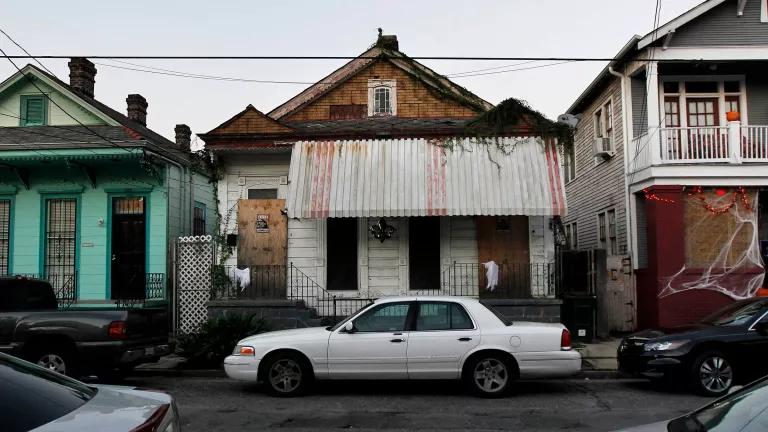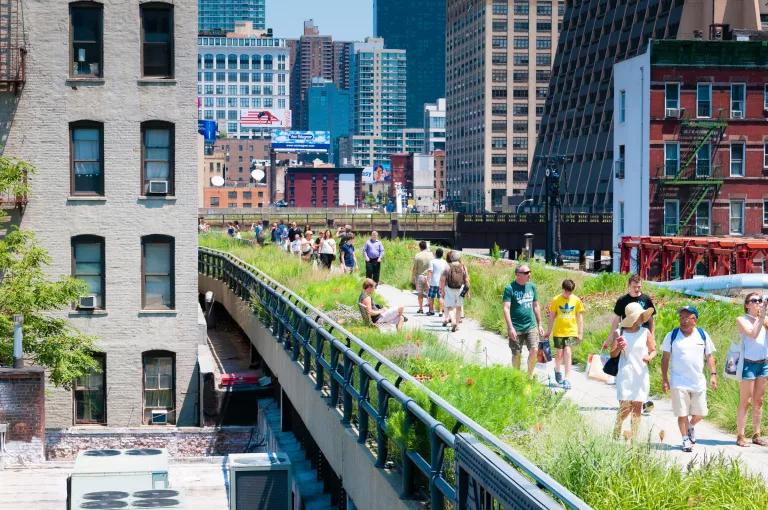
The Treme section of New Orleans
AP Photo/Gerald Herbert
The cycle is all too familiar: Affluent residents move into lower-income neighborhoods in cities and make their mark on the area’s character and culture. Property values and the cost of living rise in tandem. While the process of gentrification may revitalize under-resourced neighborhoods, the skyrocketing costs of living displace longtime residents and businesses, leaving a new demographic to enjoy the benefits.
As climate change starts to play a more significant role in where we live, it has become a trigger for gentrification and displacement in its own right. Coastal cities that lie on the frontlines of global warming have seen an influx of investments to improve climate resilience. The efforts to redevelop or build new structures that can withstand the impacts of intensifying storms, flooding, erosion, and sea-level rise may inadvertently pose new threats to low-income communities of color.
On the other hand, the lack of equitable investment in low-income communities leaves people even more at risk for climate change impacts when the development model maintains a do-nothing status quo. The same consequence can happen when high-income households relocate from flood-prone coastal properties to higher-elevation cities, displacing the residents there. Extreme weather events fueled by global climate change can also rapidly reshape a city’s identity and people’s cultural connections to places they call home.
There are a few ways you can look at the causes of climate gentrification. Sasha Forbes, a senior program advocate in NRDC’s Healthy People & Thriving Communities Program, breaks them down.
The Lure of Higher Ground
Increasingly, high-income households are moving away from coastal properties to avoid threats like sea-level rise and erosion. The lurking impacts of the climate crisis “are pushing people inland onto communities that have been rooted there and have endured disinvestment, racism, and inequality and are now under the threat of gentrification and displacement,” Forbes explains. Meanwhile, even owners of more-resilient coastal properties are eyeing properties farther from the shore due to expenses associated with climate change, such as the rising cost of flood insurance.
Residents of Liberty City in Miami are among those now facing the ramifications of climate gentrification. Sitting at a higher elevation than the rest of Miami, Liberty City is less vulnerable to the expected sea-level rise of 14 to 26 inches by 2060—and this has caught the attention of real estate developers.
A 2018 study shows that real estate sitting on higher elevation in Miami has appreciated at a faster rate than anywhere else in the country. This value appreciation has not been leveraged to collectively benefit the predominantly Black residents of Liberty City who have been fighting for more resources for their community. Not only are they seeing a shift in their neighborhood, but these residents are also under pressure from developers to sell their homes.
Evacuation from Extreme Weather
Natural disasters can also accelerate gentrification. “A large part of the reality is that Black- and brown-owned property is undervalued by the market, so in times of disasters—and we can include COVID-19 in this as well—predatory investors and developers take advantage of even cheaper property and land values than existed prior to a disaster,” Forbes says.
Recent studies have shown that Black communities are undervalued by an average of $48,000. The recovery and redevelopment period presents “a mix of residents trying to maintain or recoup what might be left of their homes; residents who have lost their jobs and are on the verge of being evicted with no option for affordable housing elsewhere; land grabs; and cities engaging in redevelopment processes that might tout equity but still create intentional strategies to attract more higher-income residents without enough emphasis on supporting existing low-income residents—all of which can lead to gentrification and displacement,” says Forbes.
Climate-related disasters in 2018 alone displaced more than 1.2 million people. These extreme weather events—which will only increase in frequency as climate change worsens—can spur immediate gentrification in under-resourced communities. In 2017, when Hurricane Harvey swept through Houston, one in six families receiving assistance from the Houston Housing Authority saw their home battered or destroyed. After the city’s many displaced families returned to seek new accommodations, they found skyrocketing rents across the city. And one year later, Houston still wouldn’t commit to rebuilding or replacing all of the lost subsidized housing.
The rebuilding of New Orleans, which bore the brunt of Hurricane Katrina in 2005, remains perhaps the starkest example of climate gentrification of a city in U.S. history. It is estimated that 100,000 Black New Orleans residents have been permanently displaced from their homes due to the destruction of affordable housing following the storm. This included the razing of some developments that saw no significant damage as part of the city’s rebuilding strategy.
Researchers have since concluded that hurricane damage was positively associated with the likelihood of a New Orleans neighborhood having gentrified 10 years after Katrina. This suggests that natural disasters can sometimes pave the way for gentrification, uprooting existing populations en masse and wiping out infrastructure. Developers can swoop in afterward and invest in properties at lower prices and build higher-end projects meant to attract a wealthier population.

The High Line in New York City
iStock
Green—but Inequitable—Investments
Forbes also points to cities’ efforts to implement eco-friendly infrastructure as a potential trigger for displacement. Green gentrification, such as the building of large-scale green spaces in neighborhoods, can inadvertently push out residents from the surrounding areas as it increases property values.
“While it is good that cities adopt green interventions to increase climate resilience, the greening can lead to gentrification and displacement, given our racially and structurally unjust planning practices and policies, which don't focus enough on keeping people in place if they so choose, especially renters,” says Forbes.
These eco-friendly amenities may only end up benefiting wealthy residents—which is what’s in danger of happening along the Los Angeles River, where profiteering developers are taking advantage of a restoration project intended to benefit surrounding ecosystems and riverside communities. One of two large projects proposed along the river, north of downtown L.A., would disrupt habitat restoration efforts and place a commercial development atop riverside land that the city had previously envisioned as part of a contiguous public park. The other proposed project features luxury housing in L.A.’s Chinatown and has already led to reports of landlords evicting long-term residents.
Other projects like the High Line in New York City, the 606 in Chicago, and the Atlanta BeltLine have prompted similar concerns of accelerated gentrification, despite their original goals of neighborhood revitalization. Forbes explains that there needs to be proactive strategies and policies tied to such projects that not only focus on anti-displacement measures but also allow low-income communities and communities of color to access the new amenities for their well being.
“Programs and policies for community ownership, cultural programs, income and workforce development that support communities should be implemented months or years ahead of the groundbreaking of any major development, as well as after the development is completed,” Forbes says. “The continued failure to do so is as dangerous as the ‘unintended consequences’ of projects that are implemented to make things better. We don’t account enough for inaction.” Urban planning and zoning are key forces driving gentrification as a whole, Forbes adds, with local governments playing a significant role in regulating these practices.
Given that reality, Forbes and national and local partners with the Strong, Prosperous, and Resilient Communities Challenge (SPARCC) say that community-led investment and self-determination by low-income communities and people of color are fundamental to any city’s revitalization projects and to determining what happens to local land. Toward that end, SPARCC collaborates with community partners and amplifies local efforts to promote equitable and sustainable development practices—not just for housing protection but also for access to public transportation, cultural preservation, and parks.
“We must have increased voice, power, and access to adaptive financial resources, especially for community-led organizations, to make sustainable, healthy, and equitable development a reality,” Forbes says. This can vary depending on the specific needs of the neighborhood. In the Bay Area, for example, 64 percent of low-income residents living near transit are at risk of displacement due to rising housing costs. To help mitigate this risk, SPARCC partners have focused on supporting the region’s community land trusts—local nonprofit organizations that ensure long-term housing affordability in a neighborhood—and have succeeded in acquiring several single-family homes in collaboration with residents, lenders, and developers.
We already know that climate justice, housing justice, racial equity, and economic opportunity are interconnected. To begin working through these issues and avoid the pitfalls of gentrification, cities need to ensure that they recalibrate their inequitable planning and economic development practices of the past and bring the decision-making table to those experiencing the issues firsthand.
This NRDC.org story is available for online republication by news media outlets or nonprofits under these conditions: The writer(s) must be credited with a byline; you must note prominently that the story was originally published by NRDC.org and link to the original; the story cannot be edited (beyond simple things such as grammar); you can’t resell the story in any form or grant republishing rights to other outlets; you can’t republish our material wholesale or automatically—you need to select stories individually; you can’t republish the photos or graphics on our site without specific permission; you should drop us a note to let us know when you’ve used one of our stories.

Climate Tipping Points Are Closer Than Once Thought
Mapping Urban Heat Islands Is Helping These Neighborhoods Adapt
How Long Does It Take to Get a FEMA Buyout for a Flooded Home?
Climate Tipping Points Are Closer Than Once Thought
Mapping Urban Heat Islands Is Helping These Neighborhoods Adapt
How Long Does It Take to Get a FEMA Buyout for a Flooded Home?
Climate Tipping Points Are Closer Than Once Thought
Mapping Urban Heat Islands Is Helping These Neighborhoods Adapt
How Long Does It Take to Get a FEMA Buyout for a Flooded Home?
Climate Tipping Points Are Closer Than Once Thought
Mapping Urban Heat Islands Is Helping These Neighborhoods Adapt